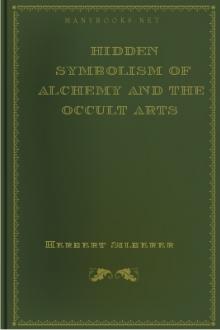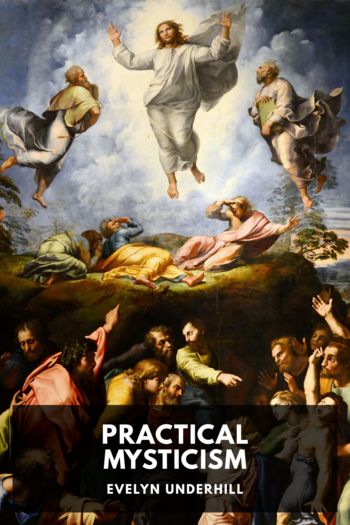Hidden Symbolism of Alchemy and the Occult Arts by Herbert Silberer (e book reader free .txt) 📕

- Author: Herbert Silberer
- Performer: -
Book online «Hidden Symbolism of Alchemy and the Occult Arts by Herbert Silberer (e book reader free .txt) 📕». Author Herbert Silberer
I said above, every one will find something appropriate to himself in the symbols, and I emphasized the great constancy of the types fast rooted in the [pg 375] unconscious, types which impart to them a universal validity. The divine is revealed “only objectively different according to the disposition of the vessel into which it falls, to one one way, another to another. To the rich poetical genius it is revealed preeminently in the activity of his imagination; to the philosophical understanding as the scheme of a harmonious system. It sinks into the depths of the soul of the religious, and exalts the strong constructive will like a divine power. And so the divine is honored differently by each one.” (Ennemoser, Gesch. d. M., p. 109.) “The spiritual element of the inheritance handed down by our fathers works out vigorously in the once for all established style.... On the dark background of the soul stand, as it were, the magic symbols in definite types, and it requires but an inner or outer touch [E.g., by religious observances.] to make them kindle and become active.” (Ib., p. 274.) “The unconscious is common to all mankind in an infinitely greater degree than the content of the individual consciousness, for it is the condensation of the historically average and oft-repeated.” (Jung, Jb. ps. F., III, pp. 169 ff.)
Whoever allows the educative symbols to work upon him, whether he sees only darkly the ethical applications typified in them, or clearly perceives them, or completely realizes them in himself, in any case he will be able to enjoy a satisfying sense of purification for his earnest endeavor in an ethical direction. The just mentioned dim perception (probably the most frequent case), does not exclude [pg 376] the existence of very clear ideas in consciousness; the person in question generally considers his ideas, although they are only masks in front of the absolute ideal, as the ultimate sense of the symbol, thus accepting one degree of significance for the complete meaning. Every one approximates the ideal as he can; the absolute ideal through his ephemeral, but attainable ideal. The highest being speaks in the inexhaustible Bhagavad-Gita:
If above I derived the instructive group of symbols from a mystic, that is not to say that it must be precisely so. I brought out this case among possible [pg 377] cases only for the reason that the mystic is the one who carries out most strenuously the ethical work of purification, and under such conditions as are most favorable to a suggestive group of symbols, and in particular those rich in characteristic types. Bear in mind the founders of religion. (They do not always have to be individuals—schools, myths.) There are, however, others than the religiously inspired natures, who are preëminently endowed to produce suggestive symbol groups with anagogic value; the artists. I suspect that it would prove that the purifying (cathartic) action of a work of art is the greater the more strongly the anagogic symbolism (the groups of types that carry it) is developed, or in other words, the more they express a tendency to a broadening of the personality. This tendency, to which belong the motives of the denial of the selfish will (father figure) of the love that is connected with sacrifice (incest motive, regeneration) of the devotion to an ideal (longing for death), etc., is manifested in the artist as also in the devout observer of the work of art in his very devotion to it. Being lost in a work of art appears to me essentially related both to introversion and to the unio mystica.
I have already spoken of the creations of the myth forming imagination and its anagogic import. In alchemy, to which I wish now to return, the mythical and the individual images meet in the most vivid way, without destroying each other.
In regard to the high ethical aspirations of alchemy, [pg 378] we understand that as a mystic art it preserves those attributes of a royal art which it seems to have had at first merely as gold making and magic. In fact what art may more justly be called royal than that of the perfection of mankind, that art which turns the dependent into the independent, the slave into a master? The freeing of the will in the mystic (and in every ethical) process has already, I believe, been commented on enough to be comprehensible. And the power of rule that has been extolled as a magical effect of the Philosopher's Stone lies in the harmonizing of the individual will with that of the world or with God's will. In the new birth—so remarks Jane Leade casually—we acquire a magic power; this occurs “through faith, that is, through the harmony of our will with the divine will. For faith puts the world in our power, inasmuch as the harmony of our will with the divine has the result of making everything ours or obedient to us. The will of the soul, when it accords wholly with the divine, is no longer a naked will lacking its raiment, power, but brings with it an invincible omnipotence.”
To-day, too, there is a royal art. Freemasonry bears this name. Not only the name but its ethical ideal connects it with the spirit of the old alchemy. This statement will probably be contradicted and meet the same denial as did once the ideas of Kernning [J. Krebs], although I think I am on different ground from that of this poetic but, in my eyes, all too uncritical author. Keep in mind the [pg 379] historical treatment mentioned in Part I, Section 4, and furthermore do not forget the psychological basis of our present modes of viewing things.
[If I wished to compare the ethical aims of both in general terms, I should run the risk of unduly expatiating on what is easily understood. Robert Fischer describes freemasonry as a society of men who have set themselves the severe task of a wise life and labor as the most difficult task, of self-knowledge, self-mastery and self-improvement,—tasks that are not finished in this life but only through death prepare us for the stage where the true consummation begins. These beautiful and straightforward words could just as well stand in an alchemistic discussion on the terrestrial and celestial. But this will suffice.]
And now permit me to present the following portrayals by Jane Leade [English mystic of the 17th century. She belonged to the philadelphian society founded by Pordage.] which I reproduce here with a few words of comment, and take them as an illustration of the beautiful spiritual union of the serious hermetic with the new royal art. The reader can draw his own conclusions. The passages are taken from Leade's “Garten-Brunn” (L. G. B.). References to Wirth are to the “Symbolisme Hermétique” (W. S. H.) of this modern author.
This mystic who is sunk in deep meditation on the noble Stone of divine Wisdom, has a vision of Sophia (Wisdom) at which she is startled. “Soon came the voice and said: Behold I am God's everlasting [pg 380] handmaid of wisdom, whom thou hast sought. I am now here to unseal for thee the treasures of the deepest wisdom of God, and to be to thee even that which Rebecca was to her son Jacob, namely, a true, natural mother. For from my body and womb shalt thou be born, conceived and reborn.” (L. G. B., I, p. 14.)
Leade is much rejoiced that the “morning star from on high” has sought her, and secludes herself for the following days to await further developments. She has still more visions of the crowned queen of heaven and was asked whether she had the desire to be taken up into the celestial company. She proves herself of constantly devoted will and from this time wisdom speaks to her as an inner illumination. (L. G. B., I, p. 15 ff.)
[Retirement is a precondition of introversion and of withdrawal into oneself. The uninitiated who is to be admitted is, to use the language of alchemy, the subjectum, in whom the process of purification is to be perfected. The alchemists put the subjectum into a narrow vessel so as to be hermetically sealed from the outer world. There it is subjected to putrefaction as in a grave. Introversion leads into the depths of one's very heart. “Where were you formed?” “In my heart [or inner man].” “Where after this?” “In the Way to the Lodge.” “What determined you...?” “My own free and unconstrained will.” The uninitiated are recommended to take counsel seriously with regard to their important resolution. “Why are you...?” [pg 381] “Because I was in darkness and desired light.” The death symbol in the sch. K. is later to be considered. I can naturally go into a few only of the analogies. The informed reader will largely increase the number of parallels very easily.]
Jane Leade seeks in the spirit for the key that can open the entrance into the great secret that lies deep hidden within her. Her effort to reach the holy city is great but at first ineffectual. [One is not admitted without further effort.] She wanders around the city and finds no entrance. [Way to the Lodge—“Why have they not led you the nearest way to the Lodge?” “In





Comments (0)